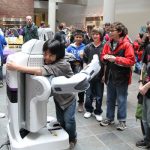 Robots are increasingly operating in close proximity to humans, so it stands to reason that the interactions between them need to improve to become as natural as possible.
Robots are increasingly operating in close proximity to humans, so it stands to reason that the interactions between them need to improve to become as natural as possible.
A recent paper from the Institute of Automatics of the National University of San Juan in Argentina explores how robots can get better at understanding, and respecting, our personal space.
“Humans respect social zones during different kind[s] of interactions,” the author says. This is further complicated by the differences in personal space depending on the cultural expectations, the unique circumstances of the task at hand and so on. “When a robot follows a human as part of a formation, it is supposed that it must also respect these social zones to improve its social acceptance.”
Impedance control
The research team aimed to regulate the social dynamics between the robot’s movements and the interactions of the robot’s environment using impedance control. They monitored the movements of a human leader and a human follower on a clearly defined track with well established borders.
This allowed the team to capture the feedback that humans use to modify their own behaviors. For instance, it clearly identified steps taken to tell someone they’re invading their personal space. These steps were marked as a social force and subsequently treated as a defined physical field.
This information was then fed to a mobile robot that was programmed to follow the human in the same way the human participant had done so previously. This time however, the robot wasn’t allowed to invade the leader’s personal space in the way the human follower had.
“Under the hypothesis that moving like human will be acceptable by humans, it is believed that the proposed control improves the social acceptance of the robot for this kind of interaction,” the team say.
The team reason that robots are much more likely to be accepted by humans if they are aware of, and respect, the various norms of social interaction that are quite subtly observed. The robot in the experiment was able to do that with regards to the personal space of the leader.
“The results show that the robot is capable of emulating the previously identified impedance and, consequently, it is believed that the proposed control can improve the social acceptance by being able to imitate this human-human dynamic behavior,” the team conclude.